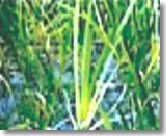
VACHA
Botanical Name: Acorus calamus Linn.( ARACEAE)
English Name: Sweet flag
Hindi Name: Vacha
Introduction: Sayana bhashya quoted this plant as important for improving the intelligence and speech of an individual ( 2/7/10-13). It is extensively used in the management of epilepsy in the ancient texts. There are two varieties viz., Vacha & Sveta Vacha. The later Variety is identified with Iris germanica.
Distribution: This is an aromatic marshy herp with creeping root-stock. It is cultivated in wet places in India.
Chemical Constituents: Acolamone, acorenone, acoragermacrone, acoramone, acorone, calacone, calcorene, calamine, calamenol, calamone, calamenone, calarene etc.
Parts Used: Rhizome
Properties: Bitter, hot, anti-epileptic, febriguge etc.
Indication: Fever, epilepsy, swellings, amnesia, schizopherenia etc.
Dose: Powder 125-500mg.
Therapeutic Uses:
- Dyspepsia: Vacha powder is administered orally with honey and jaggary.
- Swellings : Paste of Vacha and mustard (Sarshapa) may be applied externally.
Scientific Studies:
Anti-convulsent activity: The protective action of essential oil against electro-shock seizures in rats was found to compare favorably with diphenyl hydantoin ( madan et al., 1960).
Anti-microbial activity: Volatile oil from roots inhibited the growth of M. tuberculosis in a concentration of 10mcg.ml. It also inhibited the growth of gram-negative organisms in a concentration of 0.4-0.6 mg/ml (Chopra et al., 1957).
Cultivation Technology: The plant grows well in sandy-loam soils of wet and marshy places. Field should be ploughed thoroughly and farmyard manure should be added to it. It is propagated through division of rhizomes. Cutting of old rhizomes of 5-7 cm length are planted in poly-bags or directly in field in the month of July-August. The plant population should be maintained at the spacing of 30x30cm. Irrigate the field immediately after transplanting. Twice a week irrigation is required during dry and hot months.
Harvesting: Mature rhizomes are collected after 2-3years of plantation, leaving daughter (rhizomes) for subsequent regeneration.







